Sequence Stratigraphy and Implications for Shale Gas Exploration in the Southern Sichuan Basin, South China
Abstract
1. Introduction
2. Geologic Setting
2.1. Tectonic Setting
2.2. Regional Stratigraphy
3. Data and Methods
3.1. Dataset
3.2. Methodology
4. Results
4.1. Stratigraphic Sequence Surfaces
4.2. Systems Tracts of the Lower Longmaxi Formation
- high organic matter abundance with an average value of 3.78% in well N213 and 4.88% in well Y101H4-4;
- strong paleo-productivity with a mean of P/Al of 0.51 × 104 in well N213 and 138.47 × 104 in well Y101H4-4;
- weak oxidizing environment with a mean of U/Th 0.5 in well N213 and 1.12 in well Y101H4-4;
- strong hydrographic restriction with the mean of Mo/TOC of 7.32 from well N213 and 6.23 from Y101H4-4;
- low continental input for the Al2O3 content of 7.25% from N213 and 7.21% from Y101H4-4;
- and high gas content with an average value of 5.65 cc/g from well N213 and 15.5 cc/g from Y101H4-4.
4.3. Spatial Thickness Distribution of Sequences
5. Discussion
5.1. Sedimentary Evolution
5.2. Specificity of Sedimentation in the Study Area
5.3. Implications for Shale Gas Exploration
6. Conclusions
Author Contributions
Funding
Institutional Review Board Statement
Informed Consent Statement
Acknowledgments
Conflicts of Interest
References
- Chen, L.; Lu, Y.; Jiang, S.; Li, J.; Guo, T.; Luo, C.; Xing, F. Sequence stratigraphy and its application in marine shale gas exploration: A case study of the Lower Silurian Longmaxi Formation in the Jiaoshiba shale gas field and its adjacent area in southeast Sichuan Basin, SW China. J. Nat. Gas Sci. Eng. 2015, 27, 410–423. [Google Scholar] [CrossRef]
- Yang, H.; Zhao, S.; Liu, Y.; Wu, W.; Xia, Z.; Wu, T.; Luo, C.; Fan, T.; Yu, L. Main controlling factors of enrichment and high-yield of deep shale gas in the Luzhou Block, southern Sichuan Basin. Nat. Gas. Ind. 2019, 39, 55–63. [Google Scholar]
- Ma, X.; Xie, J.; Yong, R.; Zhu, Y. Geological characteristics and high production control factors of shale gas reservoirs in Silurian Longmaxi Formation, southern Sichuan Basin, SW China. Pet. Explor. Dev. 2020, 47, 901–915. [Google Scholar] [CrossRef]
- Ma, X. Enrichment laws and scale effective development of shale gas in the southern Sichuan Basin. Nat. Gas. Ind. B 2019, 6, 240–249. [Google Scholar] [CrossRef]
- Mahjour, S.K.; Al-Askari, M.K.G.; Masihi, M. Identification of flow units using methods of Testerman statistical zonation, flow zone index, and cluster analysis in Tabnaak gas field. J. Petrol. Explor. Prod. Technol. 2016, 6, 577–592. [Google Scholar] [CrossRef]
- Ahmadi, S.; Motie, M.; Soltanmohammadi, R. Proposing a modified mechanism for determination of hydrocarbons dynamic viscosity, using artificial neural network. Pet. Sci. Technol. 2020, 38, 699–705. [Google Scholar] [CrossRef]
- Motie, M.; Bemani, A.; Soltanmohammadi, R. On the estimation of phase behavior of CO2-based binary systems using ANFIS optimized by GA algorithm. In Fifth CO2 Geological Storage Workshop; European Association of Geoscientists & Engineers: Utrecht, The Netherlands, 2018; Volume 1, pp. 1–5. [Google Scholar]
- Nadjafi, M.; Mahboubi, A.; Moussavi-Harami, R.; Mirzaee, R. Depositional history and sequence stratigraphy of outcropping Tertiary carbonates in the Jahrum and Asmari formations, Shiraz area (SW Iran). J. Pet. Geol. 2004, 27, 179–190. [Google Scholar] [CrossRef]
- Catuneanu, O. Principles of Sequence Stratigraphy; Elsevier: Amsterdam, The Netherlands, 2006; 375p. [Google Scholar]
- Lash, G.G.; Engelder, T. Thickness trends and sequence stratigraphy of the Middle Devonian Marcellus Formation, Appalachian Basin: Implications for Acadian foreland basin evolution. AAPG Bull. 2011, 95, 61–103. [Google Scholar] [CrossRef]
- Slatt, R.M.; Rodriguez, N.D. Comparative sequence stratigraphy and organic geochemistry of gas shales: Commonality or coincidence? J. Nat. Gas Sci. Eng. 2012, 8, 68–84. [Google Scholar] [CrossRef]
- Wang, T.; Yang, K.; Xiong, L.; Shi, H.; Zhang, Q.; Wei, L.; He, X. Shale sequence stratigraphy of Wufeng-Longmaxi Formation in southern Sichuan and their control on reservoirs. Acta Pet. Sin. 2015, 36, 915–925. [Google Scholar]
- Wang, Y.; Dong, D.; Li, X.; Huang, J.; Wang, S.; Wu, W. Stratigraphic sequence and sedimentary characteristics of Lower Silurian Longmaxi Formation in Sichuan Basin and its peripheral areas. Nat. Gas. Ind. B 2015, 2, 222–232. [Google Scholar] [CrossRef]
- Guo, X. Sequence stratigraphy and evolution model of the Wufeng-Longmaxi shale in the Upper Yangtze area. Earth Sci. 2017, 2, 1069–1082. [Google Scholar]
- Wang, G.; Zhu, T.; Wang, H.; Wu, J.; Du, W.; Feng, D.; Wang, R. Integrated sequence stratigraphic division and vertical distribution characteristics of marine shale: A case study of the Wufeng Formation-Longmaxi Formation in southeastern Sichuan Basin. Acta Sedimentol. Sin. 2019, 37, 330–344. [Google Scholar]
- Zhu, Y.; Chen, G.; Liu, Y.; Shi, X.; Wu, W.; Luo, C.; Yang, X.; Yang, Y.; Zou, Y. Sequence stratigraphy and lithofacies paleogeographic evolution of Katian Stage—Aeronian Stage in southern Sichuan Basin, SW China. Pet. Explor. Dev. 2021, 48, 1126–1138. [Google Scholar] [CrossRef]
- Cai, Q.; Hu, M.; Kane, Q.I.; Li, M.; Zhang, B.; Hu, Z.; Deng, Q.; Xing, N. Cyclic variations in paleoenvironment and organic matter accumulation of the Upper Ordovician-Lower Silurian black shale in the Middle Yangtze Region, South China: Implications for tectonic setting, paleoclimate, and sea-level change. Mar. Pet. Geol. 2022, 136, 105777. [Google Scholar] [CrossRef]
- Catuneanu, O.; Kendall, C.; Posamentier, H. Sequence Stratigraphy: Methodology and Nomenclature. Newsl. Stratigr. 2011, 44, 173–245. [Google Scholar] [CrossRef]
- Huang, H.; He, D.; Li, Y.; Li, J.; Zhang, L. Silurian tectonic-sedimentary setting and basin evolution in the Sichuan area, southwest China: Implications for palaeogeographic reconstructions. Mar. Pet. Geol. 2018, 92, 403–423. [Google Scholar] [CrossRef]
- Yin, F.; Xu, X.; Wan, F.; Chen, M. Characteristic of sequence and stratigraphical division in evolution of Upper Yangtze region during Caledonian. J. Stratigr. 2002, 26, 315–319. [Google Scholar]
- Shi, Z.; Wang, H.; Lin, C.; Sun, S.; Jin, H.; Hao, C.; Chen, S.; Zhang, R. Paleotopography of Weiyuan-Zigong area in Wufengian-Lungmachian Stages (Ordovician-Silurian transition) and its effect on the quality of shale gas reservoir. J. Stratigra. 2020, 44, 163–173. [Google Scholar]
- Van Wagoner, J.C.; Mitchum, R.M.; Campion, K.M.; Rahmanian, V.D. Siliciclastic Sequence Stratigraphy in Well Logs, Core, and Outcrops: Concepts for High-Resolution Correlation of Time and Facies. In American Association of Petroleum Geologists Methods in Exploration Series; AAPG: Tulsa, OK, USA, 1990; 55p. [Google Scholar]
- Carter, R.M.; Fulthorpe, C.S.; Naish, T.R. Sequence concepts at seismic and outcrop scale: The distinction between physical and conceptual stratigraphic surfaces. Sediment. Geol. 1998, 122, 165–179. [Google Scholar] [CrossRef]
- Algeo, T.J.; Schwwark, L.; Hoer, J.C. High-resolution geochemistry and sequence stratigraphy of the Hushpuchney Shale (Swope Formation, Eastern Kansas): Implications for climato-environmental dynamics of the Late Pennsylvanian Midcontinent Seaway. Chem. Geol. 2004, 206, 259–288. [Google Scholar] [CrossRef]
- Ver Straeten, C.A.; Brett, C.E.; Sageman, B.B. Mudrock sequence stratigraphy: A multi-proxy (sedimentological, paleobiological and geochemical) approach, Devonian Appalachian Basin. Palaeogeogr. Palaeoclimatol. Palaeoecol. 2011, 304, 54–73. [Google Scholar] [CrossRef]
- Abouelresh, M.O.; Slatt, R.M. Lithofacies and sequence stratigraphy of the Barnett Shale in east central Fort Worth Basin, Texas. AAPG Bull. 2012, 96, 1–22. [Google Scholar] [CrossRef]
- Lagrange, M.T.; Konhauser, K.O.; Catuneanu, O.; Harris, B.S.; Playter, T.L.; Gingras, M.K. Sequence stratigraphy in organic-rich marine mudstone successions using chemostratigraphic datasets. Earth Sci. Rev. 2020, 203, 103137. [Google Scholar] [CrossRef]
- Liu, S.; Yang, Y.; Deng, B.; Zhong, Y.; Wen, L.; Sun, W.; Li, Z.; Jansa, L.; Li, J.; Song, J.; et al. Tectonic evolution of the Sichuan basin, southwest China. Earth Sci. Rev. 2021, 213, 103470. [Google Scholar] [CrossRef]
- He, D.; Li, D.; Zhang, G.; Zhao, L.; Fan, C.; Lu, R.; Wen, Z. Formation and evolution of multi-cycle superposed Sichuan Basin, China. Sci. Geol. Sin. 2011, 46, 589–606. [Google Scholar]
- Lüning, S.; Craig, J.; Loydell, D.K.; Štorch, P.; Fitches, B. Lower Silurian ‘hot shales’ in North Africa and Arabia: Regional distribution and depositional model. Earth Sci. Rev. 2000, 49, 121–200. [Google Scholar] [CrossRef]
- Feng, H.; Erdtmann, B.D.; Wang, H. Early Paleozoic whole-rock Ce anomalies and secular eustatic changes in the Upper Yangtze region. China Earth Sci. 2000, 3, 328–336. [Google Scholar] [CrossRef]
- Loydell, D.K.; Butcher, A.; Frýda, J. The middle Rhuddanian (lower Silurian) ‘hot’ shale of North Africa and Arabia: An atypical hydrocarbon source rock. Palaeogeogr. Palaeoclimatol. Palaeoecol. 2013, 386, 233–256. [Google Scholar] [CrossRef]
- Yan, D.; Chen, D.; Wang, Q.; Wang, J. Large-scale climatic fluctuations in the latest Ordovician on the Yangtze block, south China. Geology 2010, 38, 599–602. [Google Scholar] [CrossRef]
- Finnegan, S.; Bergmann, K.; Eiler, J.M.; Jones, D.S.; Fike, D.A.; Eisenman, I.; Hughes, N.C.; Tripati, A.K.; Fischer, W.W. The magnitude and duration of Late Ordovician–Early Silurian glaciation. Science 2011, 331, 903–906. [Google Scholar] [CrossRef]
- Liang, D.G.; Guo, T.L.; Bian, L.Z.; Chen, J.P.; Zhao, Z. Some progress on studies of hydrocarbon generation and accumulation in marine sedimentary regions, Southern China (part 3): Controlling factors on the sedimentary facies and development of Palaeozoic marine source rocks. Mar. Orig. Pet. Geol. 2009, 14, 1–19. [Google Scholar]
- Zeng, X.L.; Liu, S.G.; Huang, W.M.; Zhang, C.J. Comparison of Silurian Longmaxi Formation shale of Sichuan Basin in China and Carboniferous Barnett Formation shale of Fort Worth Basin in United States. Geol. Bull. China 2011, 30, 372–384. [Google Scholar]
- Chen, X.; Rong, J.; Li, Y.; Boucot, A.J. Facies patterns and geography of the Yangtze region, South China, through the Ordovician and Silurian transition. Palaeogeogr. Palaeoclimatol. Palaeoecol. 2004, 204, 353–372. [Google Scholar]
- Mou, C.; Ge, X.; Xu, X.; Zhou, K.; Liang, W.; Wang, X. Lithofacies palaeogeography of the Late Ordovician and its petroleum geological significance in Middle-Upper Yangtze Region. J. Palaeogeogr. 2014, 16, 427–440. [Google Scholar]
- Zhou, M.; Wang, R.; Li, Z. Ordovician-Silurian Lithofacies Paleogeography and Mineralization in Southern China; Geological Publishing House: Beijing, China, 1993; 122p. [Google Scholar]
- Torsvik, T.H.; Cocks, L.R.M. Gondwana from top to base in space and time. Gondwana Res. 2013, 24, 999–1030. [Google Scholar] [CrossRef]
- Sun, S.; Rui, Y.; Dong, D.; Shi, Z.; Bai, W.; Ma, C.; Zhang, L.; Wu, J.; Chang, Y. Paleogeographic evolution of the Late Ordovician-Early Silurian in Upper and Middle Yangtze regions and depositional model of shale. Oil Gas Geol. 2018, 39, 1087–1106. [Google Scholar]
- Chen, X.; Rong, J.; Mitchell, C.E.; Harper, D.A.T.; Fan, J.; Zhan, R.; Zhang, Y.; Li, R.; Wang, Y. Late Ordovician to earliest Silurian graptolite and brachiopod biozonation from the Yangtze region, South China, with a global correlation. Geol. Mag. 2000, 173, 623–650. [Google Scholar]
- Zhang, K.; Li, Z.; Jiang, S.; Jiang, Z.; Wen, M.; Jia, C.; Song, Y.; Liu, W.; Huang, Y.; Xie, X.; et al. Comparative analysis of the siliceous source and organic matter enrichment mechanism of the Upper Ordovician-Lower Silurian shale in the Upper-Lower Yangtze area. Minerals 2018, 8, 283. [Google Scholar] [CrossRef]
- Li, Y.; Zhang, T.; Ellis, G.S.; Shao, D. Depositional environment and organic matter accumulation of Upper Ordovician-Lower Silurian marine shale in the Upper Yangtze Platform, South China. Palaeogeogr. Palaeoclimatol. Palaeoecol. 2017, 466, 252–264. [Google Scholar] [CrossRef]
- Chen, X.; Fan, J.; Wang, W.; Wang, H.; Nie, H.; Shi, X.; Wen, Z.; Chen, D.; Li, W. Stage-progressive distribution pattern of the Lungmachi black graptolitic shales from Guizhou to Chongqing, Central China. Sci. China Earth Sci. 2017, 60, 1133–1146. [Google Scholar] [CrossRef]
- Fan, J.; Chen, Q.; Melchin, M.J.; David Sheets, H.; Chen, Z.; Zhang, L.; Hou, X. Quantitative stratigraphy of the Wufeng and Lungmachi black shales and graptolite evolution during and after the Late Ordovician mass extinction. Palaeogeogr. Palaeoclimatol. Palaeoecol. 2013, 389, 96–114. [Google Scholar] [CrossRef]
- Wang, H.; Shi, Z.; Zhao, Q.; Liu, D.; Sun, S.; Guo, W.; Liang, F.; Lin, C.; Wang, X. Stratigraphic framework of the Wufeng-Longmaxi shale in and around the Sichuan Basin, China: Implications for targeting shale gas. Energy Geosci. 2020, 1, 124–133. [Google Scholar] [CrossRef]
- Dong, D.; Shi, Z.; Sun, S.; Guo, C.; Zhang, C.; Guo, W.; Guan, Q.; Zhang, M.; Jiang, S.; Zhang, L.; et al. Factors controlling microfractures in black shale: A case study of Ordovician Wufeng Formation-Silurian Longmaxi Formation in Shuanghe Profile, Changning area, Sichuan Basin, SW China. Pet. Explor. Dev. 2018, 45, 818–829. [Google Scholar] [CrossRef]
- Guo, Y.; Li, Z.; Li, D.; Zhang, T.; Wang, Z.; Yu, J.; Xi, Y. Lithofacies palaeogeography of the Early Silurian in Sichuan area. J. Palaeogeogr. 2004, 6, 20–29. [Google Scholar]
- Liang, C.; Jiang, Z.; Yang, Y.; Wei, X. Shale lithofacies and reservoir space of the Wufeng-Longmaxi formation, Sichuan Basin, China. Pet. Explor. Dev 2012, 39, 736–743. [Google Scholar] [CrossRef]
- GB/T 19145-2022 2022; Determination for Total Organic Carbon in Sedimentary Rock. China Standardization Administration: Beijing, China, 2022.
- SY/T 5163-2018, 2018; Analysis Method for Clay Minerals and Ordinary Non-Clay Minerals in Sedimentary Rocks by the X-ray Diffraction. National Energy Administration of China: Beijing, China, 2018.
- Harris, N.B.; Mnich, C.A.; Selby, D.; Korn, D. Minor and trace element and Re–Os chemistry of the Upper Devonian Woodford Shale, Permian Basin, west Texas: Insights into metal abundance and basin processes. Chem. Geol. 2013, 356, 76–93. [Google Scholar] [CrossRef]
- Wei, C.; Dong, T.; He, Z.; He, S.; He, Q.; Yang, R.; Guo, X.; Hou, Y. Major, trace-elemental and sedimentological characterization of the upper Ordovician Wufeng-lower Silurian Longmaxi formations, Sichuan Basin, south China: Insights into the effect of relative sea-level fluctuations on organic matter accumulation in shales. Mar. Pet. Geol. 2021, 126, 104905. [Google Scholar] [CrossRef]
- Deng, Y.; Ren, J.; Guo, Q.; Cao, J.; Wang, H.; Liu, C. Rare earth element geochemistry characteristics of seawater and porewater from deep sea in western Pacific. Sci. Rep. 2017, 7, 16539. [Google Scholar]
- Emery, D.; Myers, K. Sequence Stratigraphy; Blackwell: Oxford, UK, 1996; 297p. [Google Scholar]
- Rider, M.H. The Geological Interpretation of Well Logs; Blackie and Son Limited: Glasgow, UK, 1986. [Google Scholar]
- Cai, Q.; Hu, M.; Ngia, N.R.; Hu, Z. Sequence stratigraphy, sedimentary systems and implications for hydrocarbon exploration in the northern Xujiaweizi Fault Depression, Songliao Basin, NE China. J. Pet. Sci. Eng. 2017, 152, 471–494. [Google Scholar] [CrossRef]
- Catuneanu, O. Model-independent sequence stratigraphy. Earth Sci. Rev. 2019, 188, 312–388. [Google Scholar] [CrossRef]
- Wang, Y.; Dong, D.; Huang, J.; Li, X.; Wang, S. Guanyinqiao Member lithofacies of the Upper Ordovician Wufeng Formation around the Sichuan Basin and the significance to shale gas plays, SW China. Pet. Explor. Dev. 2016, 43, 45–53. [Google Scholar] [CrossRef]
- Haq, B.U.; Schutter, S.R. A chronology of Paleozoic sea-level changes. Science 2008, 322, 64–68. [Google Scholar] [CrossRef]
- Wang, Y.; Li, X.; Wang, H.; Jiang, S.; Chen, B.; Ma, J.; Dai, B. Developmental characteristics and geological significance of the bentonite in the Upper Ordovician Wufeng-Lower Silurian Longmaxi Formation in eastern Sichuan Basin, SW China. Pet. Explor. Dev. 2019, 46, 687–700. [Google Scholar] [CrossRef]
- Tribovillard, N.; Algeo, T.J.; Lyons, T.; Riboulleau, A. Trace metals as paleoredox and paleoproductivity proxies: An update. Chem. Geol. 2006, 232, 12–32. [Google Scholar] [CrossRef]
- Jones, B.; Manning, D.A.C. Comparison of geochemical indices used for the interpretation of palaeoredox conditions in ancient mudstones. Chem. Geol. 1994, 111, 111–129. [Google Scholar] [CrossRef]
- Algeo, T.J.; Lyons, T.W. Mo–total organic carbon covariation in modern anoxic marine environments: Implications for analysis of paleoredox and paleohydrographic conditions. Paleoceanography 2006, 21, PA1016. [Google Scholar] [CrossRef]
- Chen, H.F.; Yeh, P.Y.; Song, S.R.; Hsu, S.; Yang, T.; Wang, Y.; Chi, Z.; Lee, T.; Chen, M.; Cheng, C.; et al. The Ti/Al molar ratio as a new proxy for tracing sediment transportation processes and its application in aeolian events and sea level change in East Asia. J. Asian Earth Sci. 2013, 73, 31–38. [Google Scholar] [CrossRef]
- Armstrong, H.A.; Turner, B.R.; Makhlouf, I.M.; Weedon, G.P.; Willianms, M.; Smadi, A.A.; Salah, A.A. Origin, sequence stratigraphy and depositional environment of an upper Ordovician (Hirnantian) deglacial black shale, Jordan. Palaeogeogr. Palaeoclimatol. Palaeoecol. 2005, 220, 273–289. [Google Scholar] [CrossRef]
- Armstrong, H.A.; Abbott, G.D.; Turner, B.R.; Makhlouf, I.M.; Muhammad, A.B.; Pedentchouk, N.; Peters, H. Black shale deposition in an Upper Ordovician-Silurian permanently stratified, peri-glacial basin, southern Jordan. Palaeogeogr. Palaeoclimatol. Palaeoecol. 2009, 273, 368–377. [Google Scholar] [CrossRef]
- Loydell, D.K.; Butcher, A.; Frýda, J.; Lüning, S.; Fowler, M. Lower Silurian “Hot Shales” in Jordan: A new depositional model. J. Pet. Geol. 2009, 32, 261–270. [Google Scholar] [CrossRef]
- Zou, C.; Qiu, Z.; Poulton, S.W.; Dong, D.; Wang, H.; Chen, D.; Lu, B.; Shi, Z.; Tao, H. Ocean euxinia and climate change “double whammy” drove the Late Ordovician mass extinction. Geology 2018, 46, 535–538. [Google Scholar] [CrossRef]
- Yan, D.; Chen, D.; Wang, Z.; Li, J.; Yang, X.; Zhang, B. Climatic and oceanic controlled deposition of Late Ordovician-Early Silurian black shales on the North Yangtze platform, South China. Mar. Pet. Geol. 2019, 110, 112–121. [Google Scholar]
- Li, Y.; Zhang, T.; Shen, B.; Li, Z.; Shao, D.; Lash, G.G. Carbon and sulfur isotope variations through the Upper Ordovician and Lower Silurian of South China linked to volcanism. Palaeogeogr. Paleoclimatol. Palaeoecol. 2021, 567, 110285. [Google Scholar] [CrossRef]
- Finney, S.C.; Berry, W.B.N.; Cooper, J.D.; Ripperdan, R.L.; Sweet, W.C.; Jacobson, S.R.; Soufiane, A.; Achab, A.; Noble, P.J. Late Ordovician mass extinction: A new perspective from stratigraphic sections in central Nevada. Geology 1999, 27, 215–218. [Google Scholar] [CrossRef]
- Trotter, J.A.; Williams, I.; Barnes, C.R.; Lécuyer, C.; Nicoll, R.S. Did cooling oceans trigger Ordovician biodiversification? Evidence from conodont thermometry. Science 2008, 321, 550–554. [Google Scholar] [CrossRef]
- Sheehan, P.M. The Late Ordovician Mass Extinction. Ann. Rev. Earth Planet. Sci. 2001, 29, 331–364. [Google Scholar] [CrossRef]
- Liu, Z.; Algeo, T.J.; Guo, X.; Fan, J.; Du, X.; Lu, Y. Paleo-environmental cyclicity in the Early Silurian Yangtze Sea (South China): Tectonic or glacio-eustatic control? Palaeogeogr. Palaeoclimatol. Palaeoecol. 2017, 466, 59–76. [Google Scholar] [CrossRef]
- Wang, Y.M.; Li, X.; Dong, D.; Zhang, C.; Wang, S. Main factors controlling the sedimentation of high-quality shale in the Wufeng-Longmaxi Fm, Upper Yangtze region. Nat. Gas Ind. B 2017, 4, 327–339. [Google Scholar] [CrossRef]
- Wang, Y.; Chen, B.; Li, X.; Wang, H.; Chang, L.; Jiang, S. Sedimentary characteristics of upwelling facies shale in Lower Silurian Longmaxi Formation, northeast Sichuan area. Acta Pet. Sin. 2018, 39, 1092–1102. [Google Scholar]
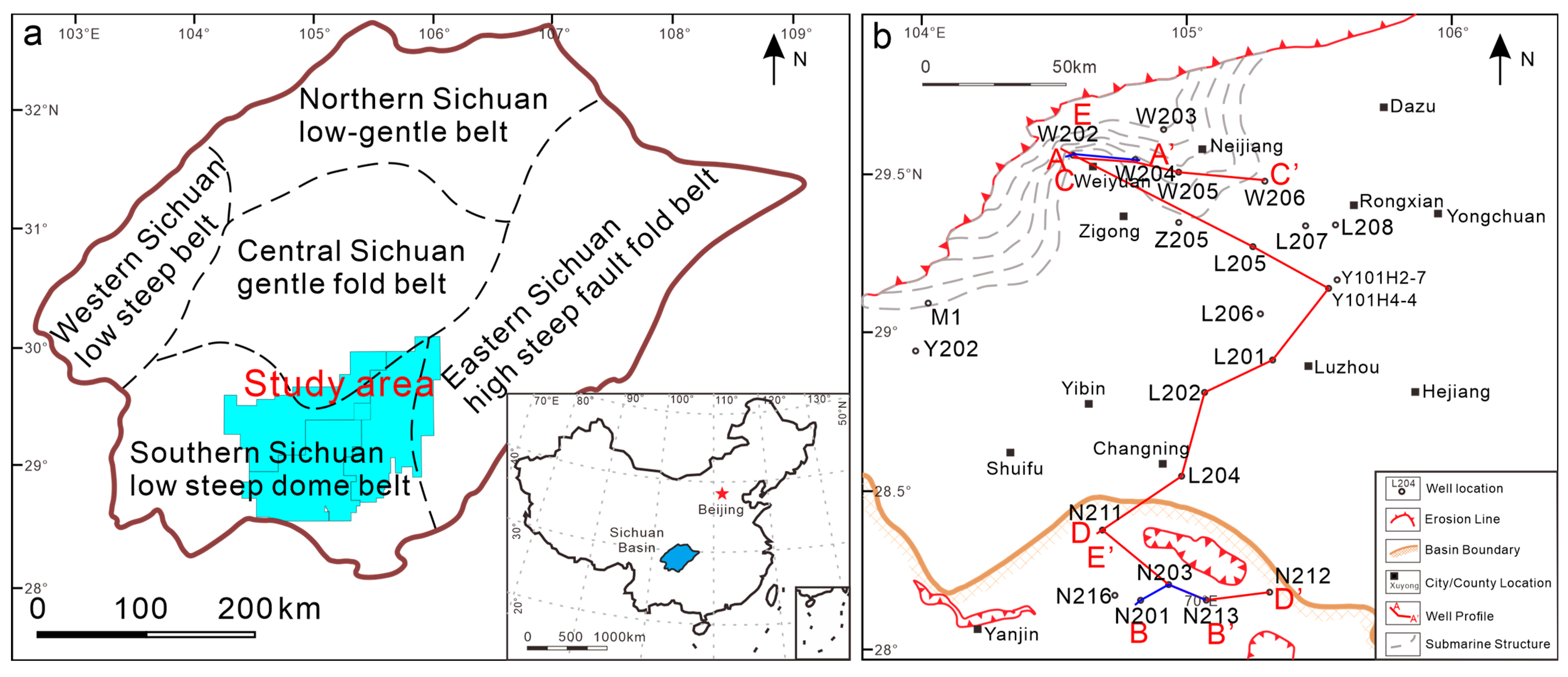
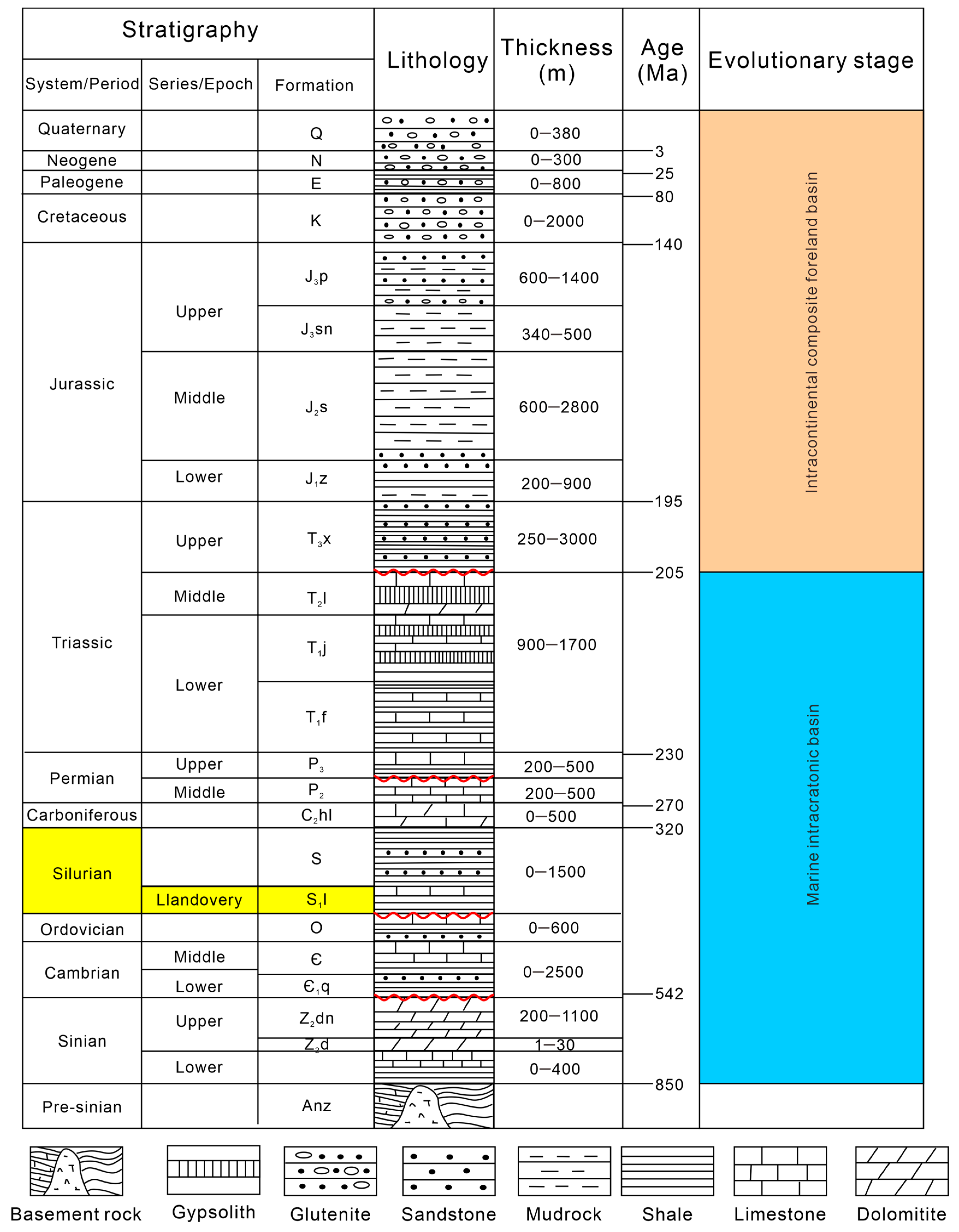
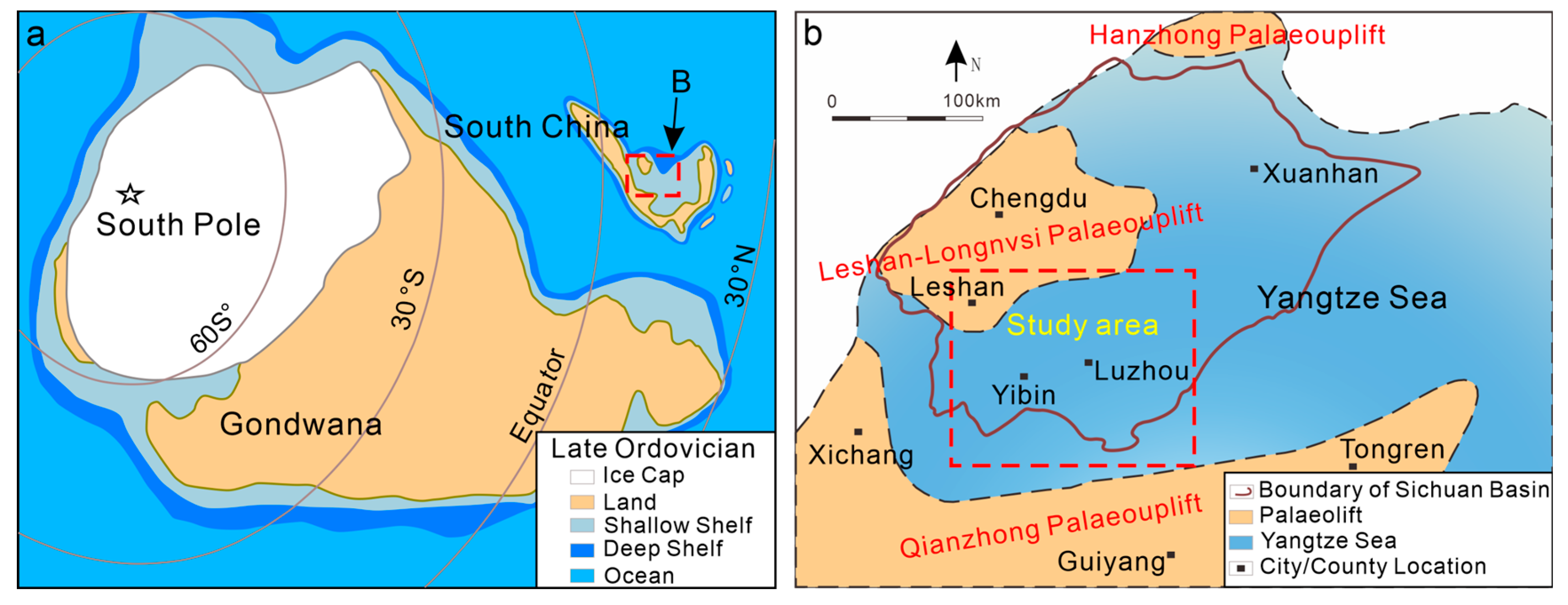
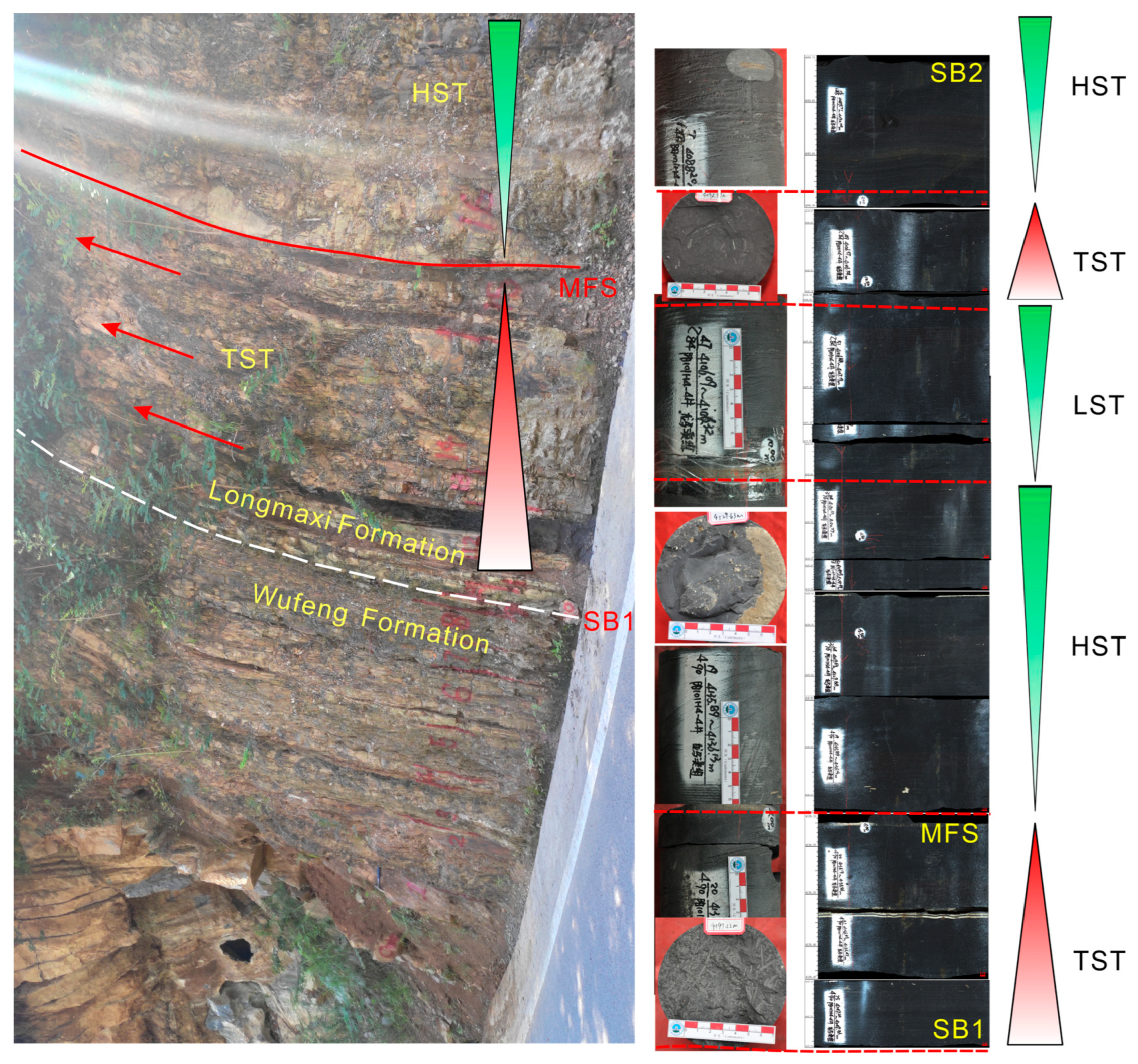
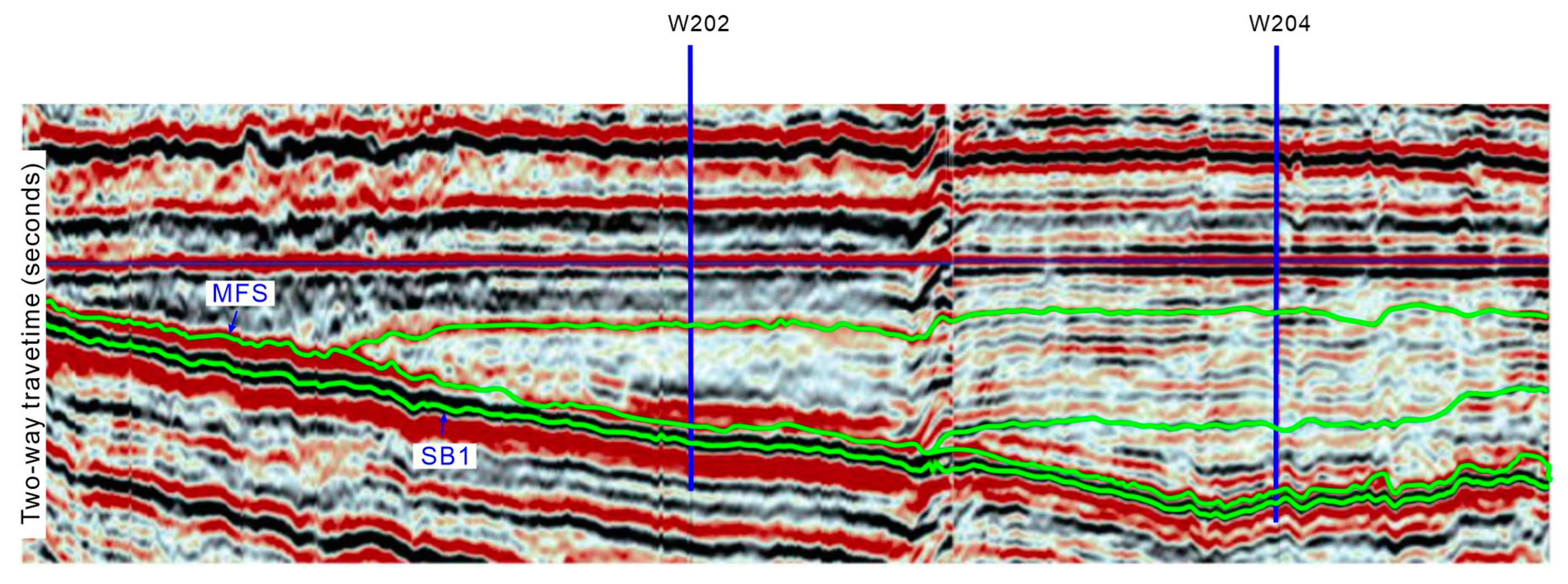
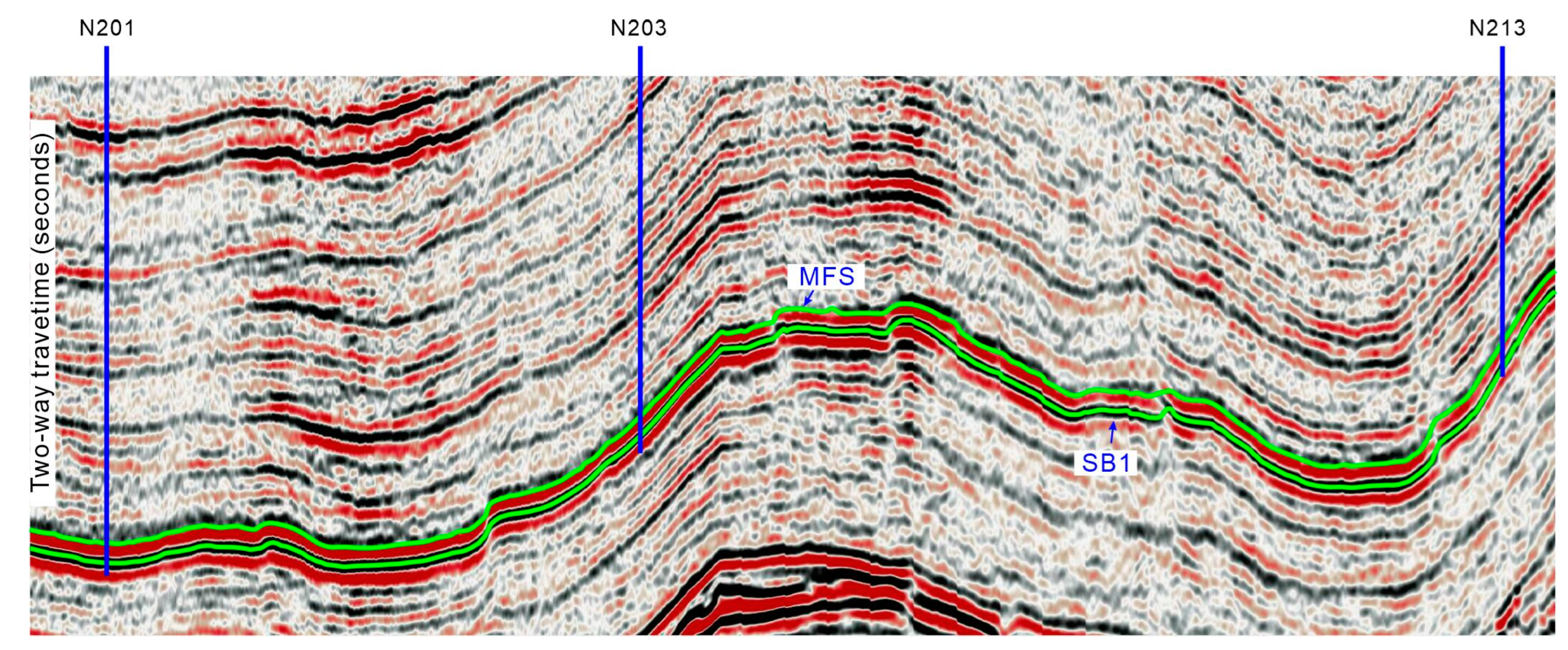
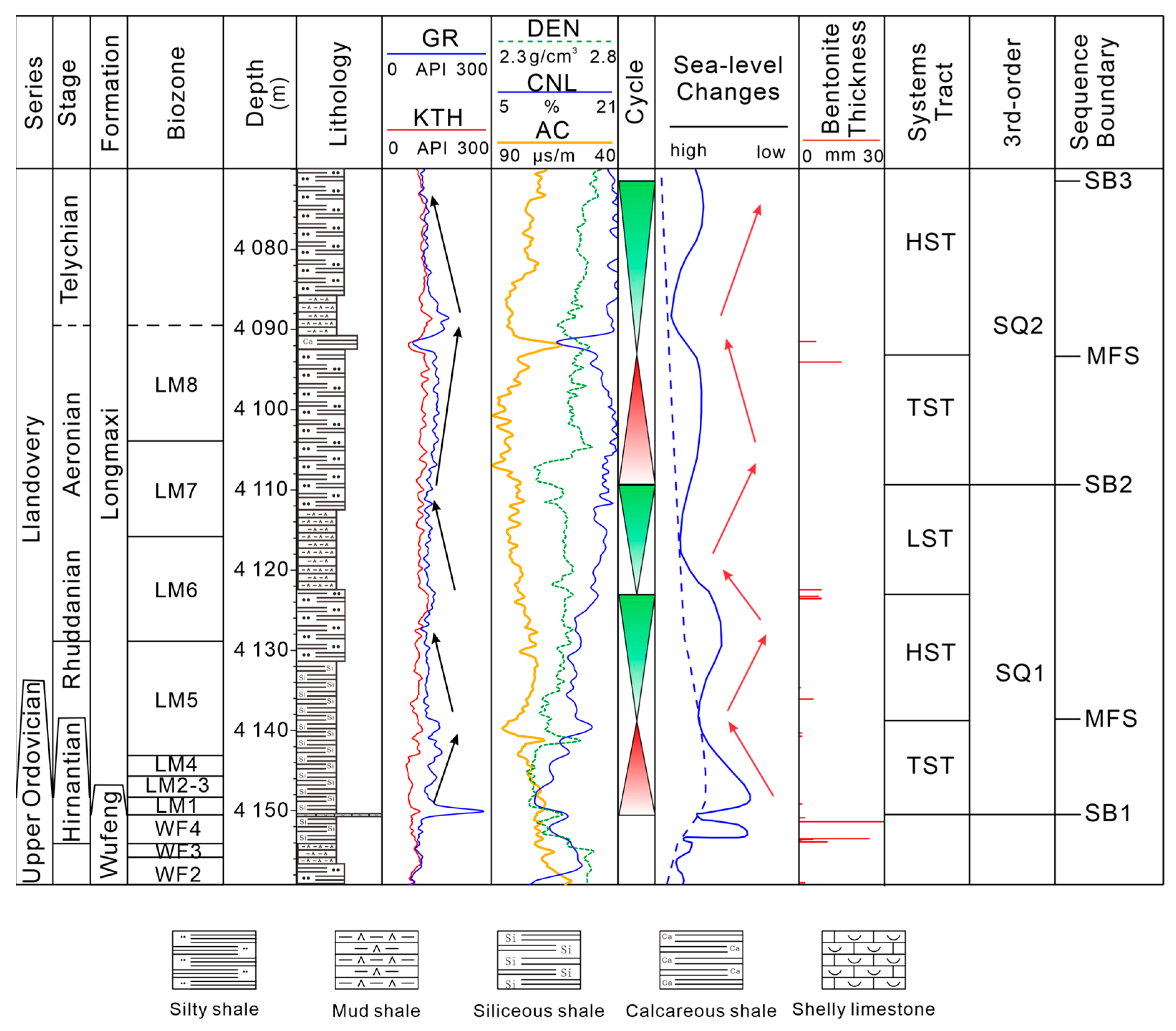
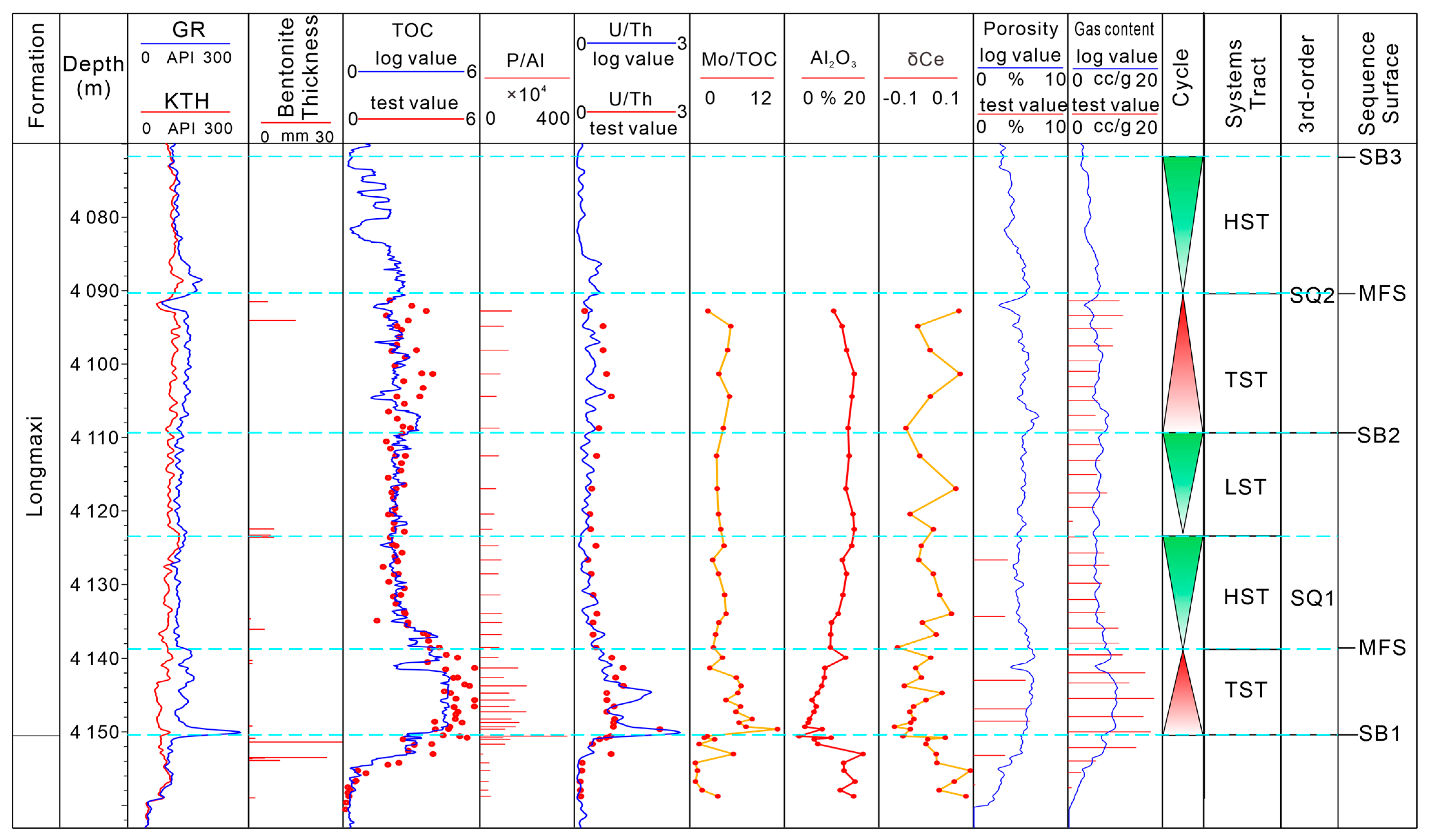
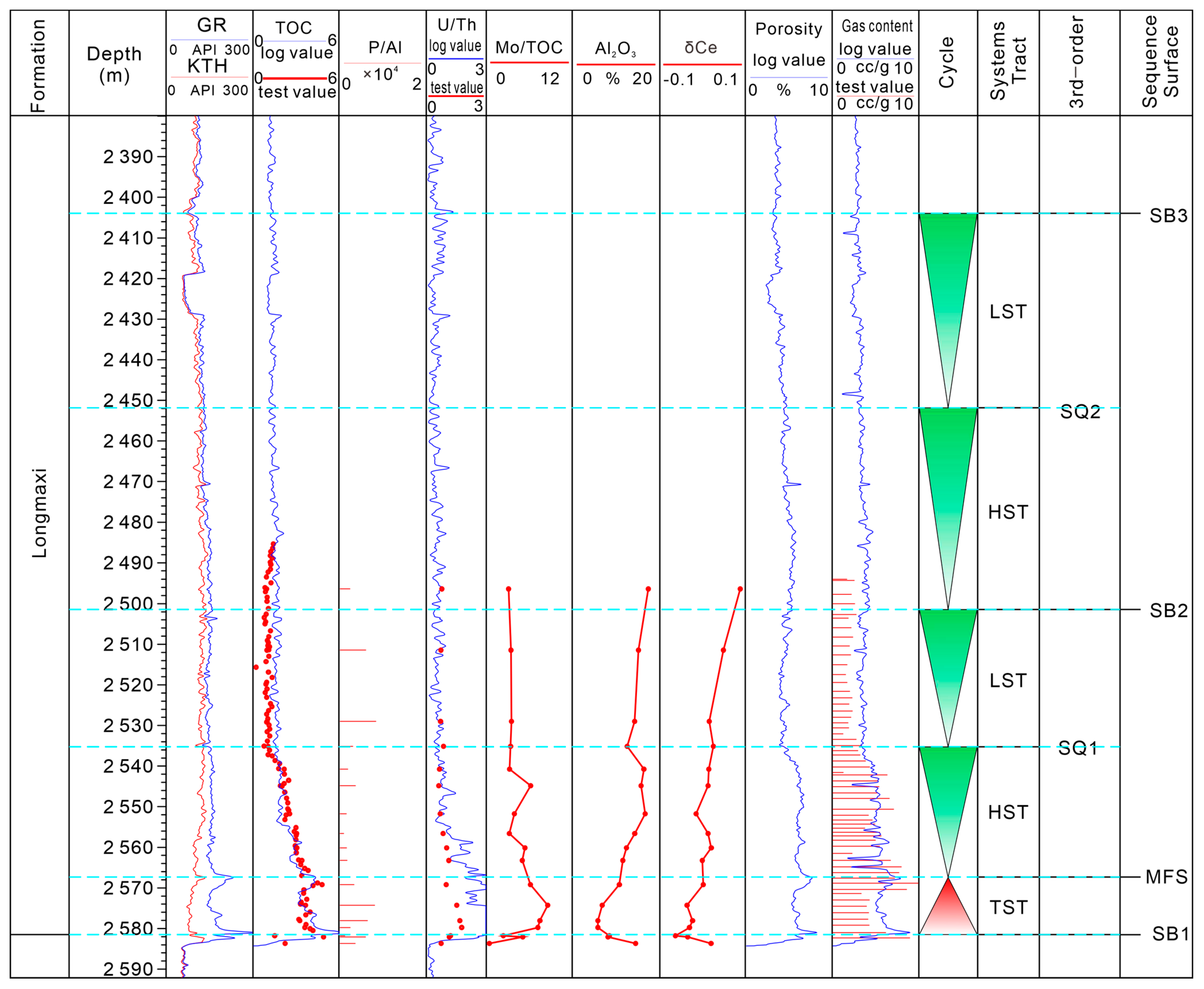

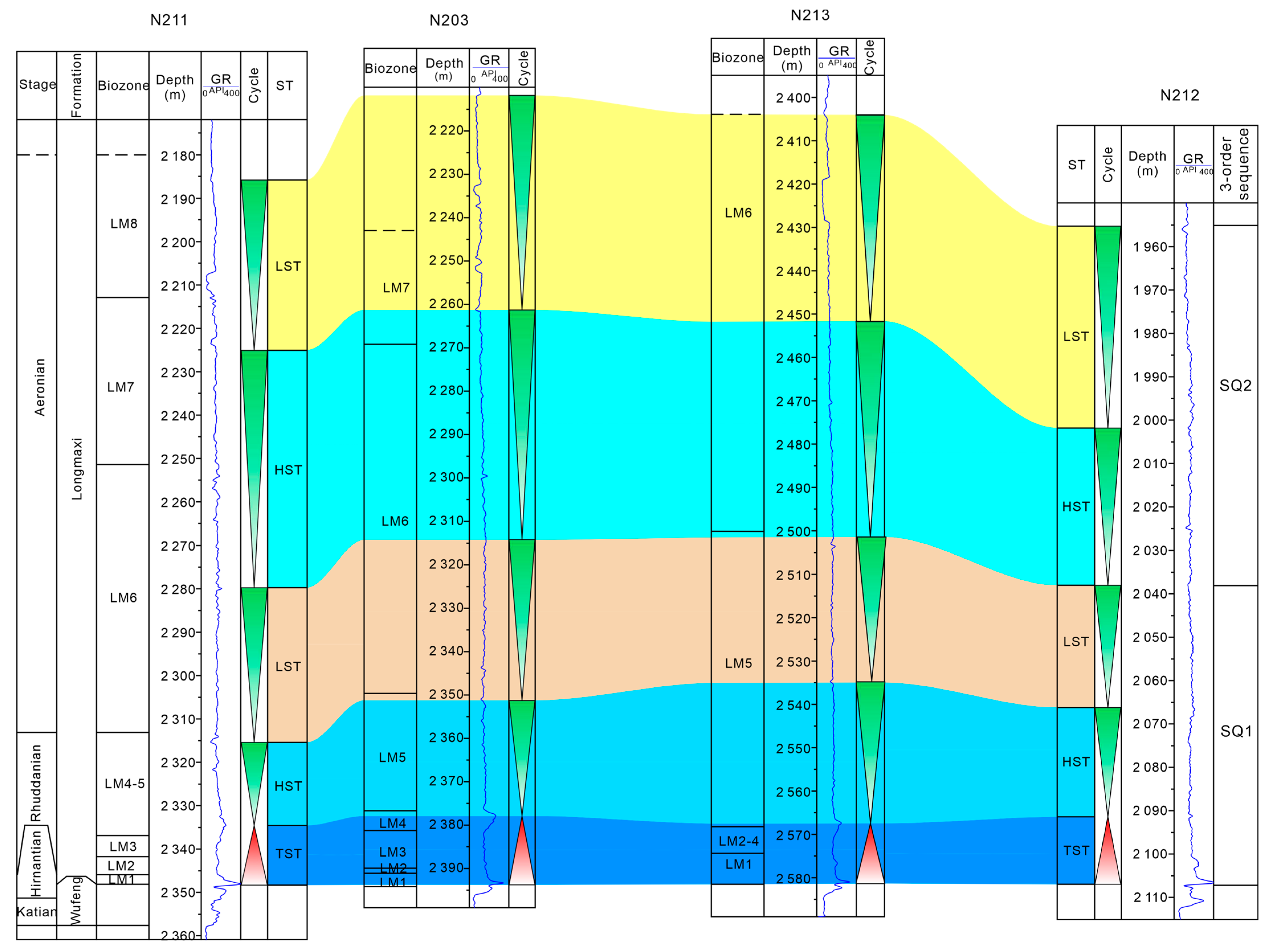
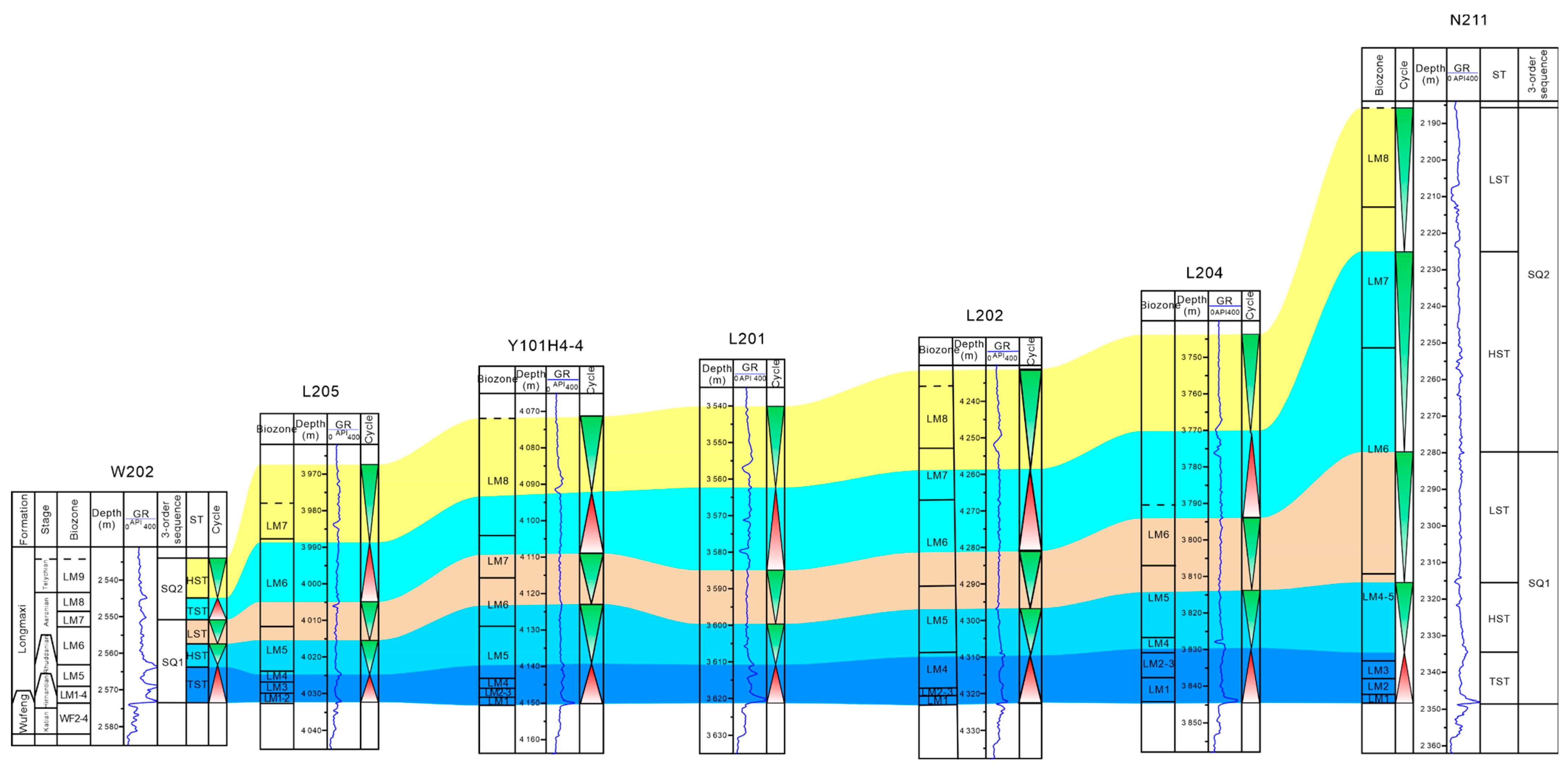
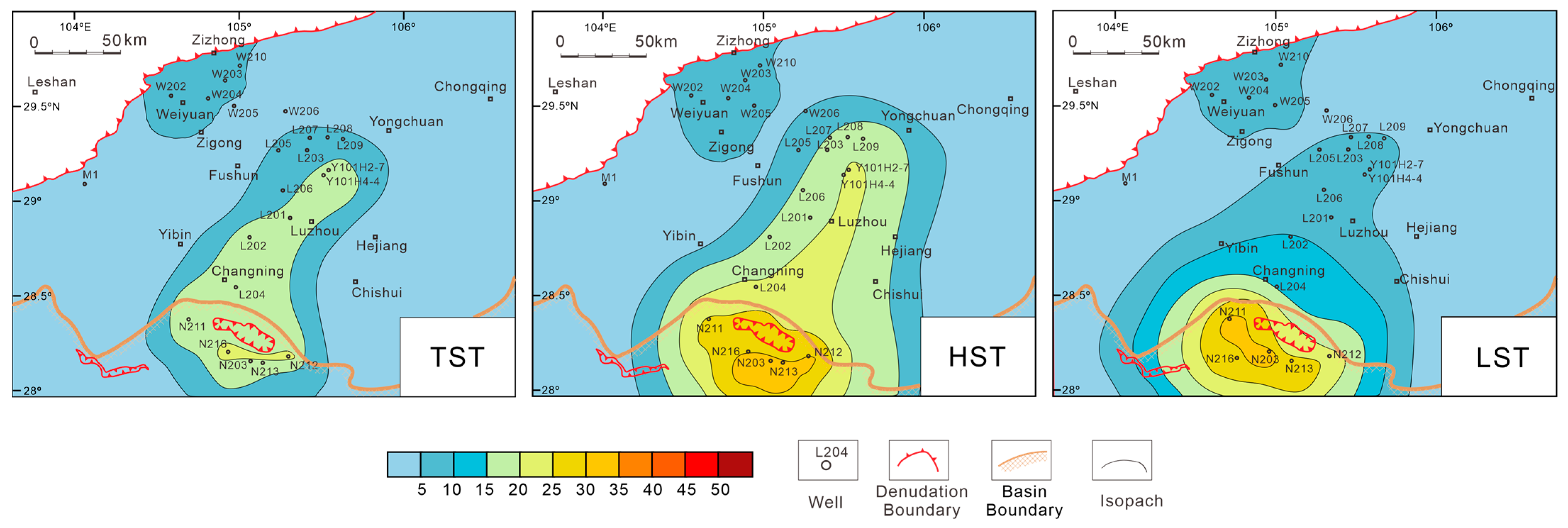
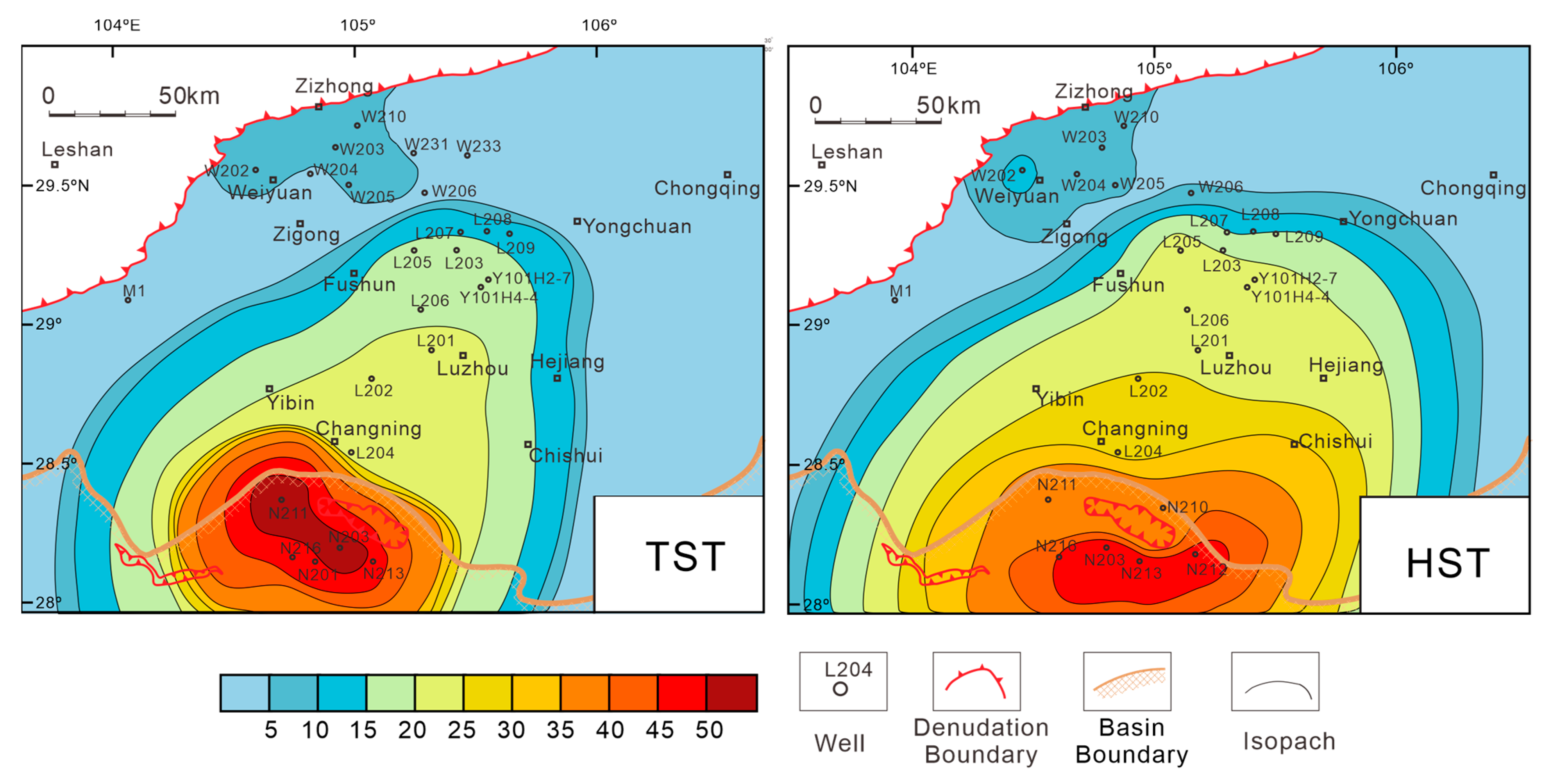

| Biozone | Age (Ma) | N213 | L204 | Y101H4-4 | L205 | W204H10-2 | |||||
|---|---|---|---|---|---|---|---|---|---|---|---|
| Thickness (m) | Rate (m/Ma) | Thickness (m) | Rate (m/Ma) | Thickness (m) | Rate (m/Ma) | Thickness (m) | Rate (m/Ma) | Thickness (m) | Rate (m/Ma) | ||
| Spirograptus guerichi (LM9) | 438.49 | / | / | / | / | / | / | / | / | >29 | >80.42 |
| Stimulograptus sedgwickii (LM8) | 438.76 | / | / | / | / | >14 | >51.85 | / | / | 17.65 | 24.51 |
| Lituigraptus convolutes (LM7) | 439.21 | / | / | / | / | 11.93 | 26.51 | >27 | >61.02 | ||
| Demirastrites triangulates (LM6) | 440.77 | >23.99 | >15.38 | >35 | >22.44 | 13.04 | 8.36 | 23.93 | 15.34 | 14.03 | 8.99 |
| Coronograptus cyphus (LM5) | 441.57 | 68.04 | 85.05 | 21.69 | 27.11 | 14.24 | 17.8 | 12.19 | 15.24 | 3.24 | 4.05 |
| Cystograptus vesiculosus (LM4) | 442.47 | 5.89 | 2.61 | 6.77 | 7.52 | 2.58 | 2.87 | 2.98 | 3.31 | 1.82 | 2.02 |
| Parakidogr. Acuminatus (LM3) | 443.40 | 3.85 | 2.83 | 2.65 | 1.95 | 3.07 | 3.30 | 1.95 | 2.1 | ||
| Akidograptus ascensus (LM2) | 443.83 | 2.7 | 2.62 | 1.56 | 3.63 | ||||||
| Persculptogr. Persculptus (LM1) | 444.43 | 7.2 | 12 | 6.6 | 11 | 2.18 | 3.63 | 0.6 | 1 | ||
Disclaimer/Publisher’s Note: The statements, opinions and data contained in all publications are solely those of the individual author(s) and contributor(s) and not of MDPI and/or the editor(s). MDPI and/or the editor(s) disclaim responsibility for any injury to people or property resulting from any ideas, methods, instructions or products referred to in the content. |
© 2023 by the authors. Licensee MDPI, Basel, Switzerland. This article is an open access article distributed under the terms and conditions of the Creative Commons Attribution (CC BY) license (https://creativecommons.org/licenses/by/4.0/).
Share and Cite
Xu, L.; Meng, J.; Pan, R.; Yang, X.; Sun, Q.; Zhu, B. Sequence Stratigraphy and Implications for Shale Gas Exploration in the Southern Sichuan Basin, South China. J. Mar. Sci. Eng. 2023, 11, 1393. https://doi.org/10.3390/jmse11071393
Xu L, Meng J, Pan R, Yang X, Sun Q, Zhu B. Sequence Stratigraphy and Implications for Shale Gas Exploration in the Southern Sichuan Basin, South China. Journal of Marine Science and Engineering. 2023; 11(7):1393. https://doi.org/10.3390/jmse11071393
Chicago/Turabian StyleXu, Lingling, Jianghui Meng, Renfang Pan, Xue Yang, Qimeng Sun, and Boyuan Zhu. 2023. "Sequence Stratigraphy and Implications for Shale Gas Exploration in the Southern Sichuan Basin, South China" Journal of Marine Science and Engineering 11, no. 7: 1393. https://doi.org/10.3390/jmse11071393
APA StyleXu, L., Meng, J., Pan, R., Yang, X., Sun, Q., & Zhu, B. (2023). Sequence Stratigraphy and Implications for Shale Gas Exploration in the Southern Sichuan Basin, South China. Journal of Marine Science and Engineering, 11(7), 1393. https://doi.org/10.3390/jmse11071393







